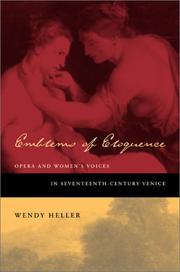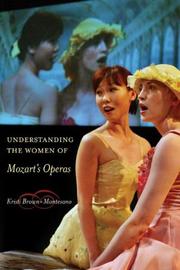| Listing 1 - 4 of 4 |
Sort by
|

ISBN: 1282356690 0520919343 9786612356698 159734592X 9780520919341 0520209338 9780520209336 9781597345927 Year: 2003 Publisher: Berkeley : University of California Press,
Abstract | Keywords | Export | Availability | Bookmark
 Loading...
Loading...Choose an application
- Reference Manager
- EndNote
- RefWorks (Direct export to RefWorks)
Opera developed during a time when the position of women-their rights and freedoms, their virtues and vices, and even the most basic substance of their sexuality-was constantly debated. Many of these controversies manifested themselves in the representation of the historical and mythological women whose voices were heard on the Venetian operatic stage. Drawing upon a complex web of early modern sources and ancient texts, this engaging study is the first comprehensive treatment of women, gender, and sexuality in seventeenth-century opera. Wendy Heller explores the operatic manifestations of female chastity, power, transvestism, androgyny, and desire, showing how the emerging genre was shaped by and infused with the Republic's taste for the erotic and its ambivalent attitudes toward women and sexuality. Heller begins by examining contemporary Venetian writings about gender and sexuality that influenced the development of female vocality in opera. The Venetian reception and transformation of ancient texts-by Ovid, Virgil, Tacitus, and Diodorus Siculus-form the background for her penetrating analyses of the musical and dramatic representation of five extraordinary women as presented in operas by Claudio Monteverdi, Francesco Cavalli, and their successors in Venice: Dido, queen of Carthage (Cavalli); Octavia, wife of Nero (Monteverdi); the nymph Callisto (Cavalli); Queen Semiramis of Assyria (Pietro Andrea Ziani); and Messalina, wife of Claudius (Carlo Pallavicino).
Women in opera. --- Opera --- Comic opera --- Lyric drama --- Opera, Comic --- Operas --- Drama --- Dramatic music --- Singspiel --- History and criticism --- 17th century. --- androgyny. --- antiquity. --- callisto. --- carthage. --- cavalli. --- chastity. --- classical. --- classicism. --- desire. --- dido. --- diodorus siculus. --- drama. --- empress. --- erotic. --- female characters. --- female power. --- female vocality. --- feminism. --- gender studies. --- gender. --- messalina. --- monteverdi. --- music. --- musicology. --- mythological women. --- mythology. --- nonfiction. --- nymph. --- octavia. --- opera women. --- opera. --- ovid. --- pallavicino. --- performing arts. --- purity. --- semiramis. --- sexuality. --- tacitus. --- theater. --- transvestism. --- venetian opera. --- virgil. --- women. --- womens rights. --- ziani.

ISBN: 052093296X 9780520932968 0520248023 9780520248021 0520248023 9780520248021 Year: 2007 Publisher: Berkeley, Calif. London University of California Press
Abstract | Keywords | Export | Availability | Bookmark
 Loading...
Loading...Choose an application
- Reference Manager
- EndNote
- RefWorks (Direct export to RefWorks)
Is The Marriage of Figaro just about Figaro? Is Don Giovanni's story the only one-or even the most interesting one-in the opera that bears his name? For generations of critics, historians, and directors, it's Mozart's men who have mattered most. Too often, the female characters have been understood from the male protagonist's point of view or simply reduced on stage (and in print) to paper cutouts from the age of the powdered wig and the tightly cinched corset. It's time to give Mozart's women-and Mozart's multi-dimensional portrayals of feminine character-their due. In this lively book, Kristi Brown-Montesano offers a detailed exploration of the female roles in Mozart's four most frequently performed operas, Le nozze di Figaro, Don Giovanni, Così fan tutte, and Die Zauberflöte. Each chapter takes a close look at the music, libretto text, literary sources, and historical factors that give shape to a character, re-evaluating common assumptions and proposing fresh interpretations.Brown-Montesano views each character as the subject of a story, not merely the object of a hero's narrative or the stock figure of convention. From amiable Zerlina, to the awesome Queen of the Night, to calculating Despina, all of Mozart's women have something unique to say. These readings also tackle provocative social, political, and cultural issues, which are used in the operas to define positive and negative images of femininity: revenge, power, seduction, resistance, autonomy, sacrifice, faithfulness, class, maternity, and sisterhood. Keenly aware of the historical gap between the origins of these works and contemporary culture, Brown-Montesano discusses how attitudes about such concepts-past and current-influence our appreciation of these fascinating representations of women.
Operas --- Women in opera. --- Opera --- Opera characters --- Operatic characters --- Characters. --- Characters --- Mozart, Wolfgang Amadeus, --- Mozart, Wolfgang Amadeus --- academia. --- academic studies. --- class in opera. --- cosi fan tutte. --- die zauberflote. --- don giovanni. --- famous opera. --- femininity. --- feminism in classical music. --- feminist studies. --- heros narrative. --- historical gap. --- le nozze di gargo. --- libretto text. --- literary analysis. --- male protagonist. --- marriage of figaro. --- maternity. --- men who wrote women well. --- mozart and women. --- multi-dimensional female characters. --- music appreciation. --- music history. --- political issues within opera. --- provocative social issues. --- sisterhood.
Book
ISBN: 0520972236 0520301668 Year: 2019 Publisher: Oakland University of California Press
Abstract | Keywords | Export | Availability | Bookmark
 Loading...
Loading...Choose an application
- Reference Manager
- EndNote
- RefWorks (Direct export to RefWorks)
Learn more at www.luminosoa.org.Impersonations: The Artifice of Brahmin Masculinity in South Indian Dance centers on an insular community of Smarta Brahmin men from the Kuchipudi village in Telugu-speaking South India who are required to don stri-vesam (woman's guise) and impersonate female characters from Hindu religious narratives. Impersonation is not simply a gender performance circumscribed to the Kuchipudi stage, but a practice of power that enables the construction of hegemonic Brahmin masculinity in everyday village life. However, the power of the Brahmin male body in stri-vesam is highly contingent, particularly on account of the expansion of Kuchipudi in the latter half of the twentieth century from a localized village performance to a transnational Indian dance form. This book analyzes the practice of impersonation across a series of boundaries-village to urban, Brahmin to non-Brahmin, hegemonic to non-normative-to explore the artifice of Brahmin masculinity in contemporary South Indian dance.
Brahmans --- Female impersonators --- Gender identity in dance --- Kuchipudi (Dance) --- SOCIAL SCIENCE / Anthropology / General. --- Dance --- Cross-dressers (Female impersonators) --- Crossdressers (Female impersonators) --- Impersonators, Female --- Impersonators of women --- Persons --- Brahmins --- Caste --- Ethnology --- Hindus --- Kuchipudi Bharatam --- Social life and customs. --- Social aspects --- 20th century. --- brahmin to non brahmin. --- female characters. --- gender performance. --- hindu religious narratives. --- impersonation. --- kuchipudi village. --- localized village performance. --- male body. --- masculinity. --- men. --- practice of impersonation. --- smarta brahmin. --- south india. --- stage. --- stri vesham. --- telugu. --- transnational indian dance form. --- village to urban.
Book
ISBN: 1786948443 1786945010 1786940787 Year: 2017 Publisher: Liverpool : Liverpool University Press,
Abstract | Keywords | Export | Availability | Bookmark
 Loading...
Loading...Choose an application
- Reference Manager
- EndNote
- RefWorks (Direct export to RefWorks)
'Disabled Bodies in Early Modern Spanish Literature: Prostitutes, Aging Women and Saints provides a politically urgent critical approach to disability and female corporeality in early modern Spanish literary and social discourse. Rigorous in its historical contextualization and offering innovative, compelling readings of classic works, this book challenges familiar interpretations of women's bodies in texts of this period, transforming prior disciplinary boundaries and categories of analysis.' Professor Susan Antebi, University of Toronto 'Blending historical context and literary text with disability studies method, Encarnación Juárez-Almendros sets out to challenge the foundations of early modern scholarship through a long-awaited critical feminist examination of disability as both a social construction and an embodied material experience.' Benjamin Fraser, Professor and Chair, Thomas Harriot College of Arts & Sciences, East Carolina University Disabled Bodies in Early Modern Spanish Literature: Prostitutes, Aging Women and Saints examines the concepts and role of women in selected Spanish discourses and literary texts from the late fifteenth to seventeenth centuries from the perspective of feminist disability theories. This study explores a wide range of Spanish medical, regulatory and moral discourses, illustrating how such texts inherit, reproduce and propagate an amalgam of Western traditional concepts of female embodiment. It goes on to examine concrete representations of deviant female characters, focusing on the figures of syphilitic prostitutes and physically decayed aged women in literary texts such as Celestina, Lozana andaluza and selected works by Cervantes and Quevedo. Finally, an analysis of the personal testimony of Teresa de Avila, a nun suffering neurological disorders, complements the discussion of early modern women's disability. By expanding the meanings of contemporary theories of materiality and the social construction of disability, the book concludes that paradoxically, femininity, bodily afflictions, and mental instability characterized the new literary heroes at the very time Spain was at the apex of its imperial power. Ultimately, as this study shows, the broken female bodies of pre-industrial Spanish literature reveal the cracks in the foundational principles of power and established truths.
Spanish literature --- Women with disabilities in literature. --- Women in literature. --- History and criticism. --- Woman (Christian theology) in literature --- Women in drama --- Women in poetry --- Physically handicapped women in literature --- Sex role in literature. --- Literature --- Literary Theory --- Literature History and Criticism --- Fiction --- Novelists and Prose Writers --- Literary Studies - c 1500 to c 1800 --- Hispanic and Latino Studies --- Spain --- Modern Period --- Women's Bodies --- Disability --- Spanish medical discourses --- monstrous mother --- Feminist disability --- deviance --- Early modern Spanish literature --- Celestina --- Lozana andaluza --- deviant female characters --- disability theory --- Syphilis --- procuresses --- Early modern female corporality --- Quevedo --- midwives --- Cervantes --- Teresa de Avila --- Aging
| Listing 1 - 4 of 4 |
Sort by
|

 Search
Search Feedback
Feedback About
About Help
Help News
News